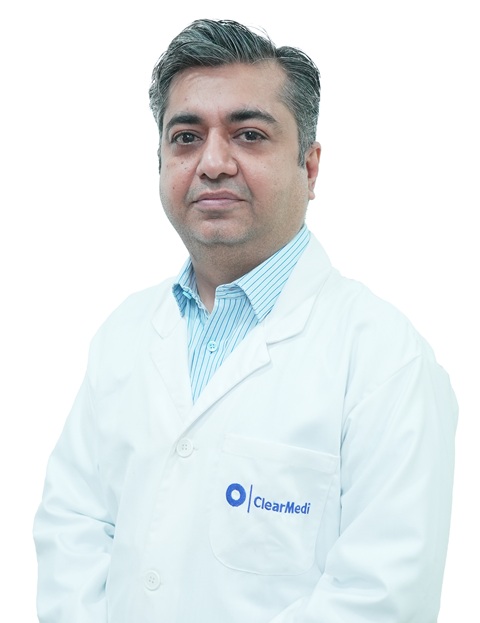Biliary Atresia Radiology - Ultrasound, MRI and Assistant

Quick Summary
- Biliary atresia is a condition that obstructs bile flow from the liver to the small intestine
- It can be diagnosed using ultrasound, MRI, and biliary atresia radiology assistant
- Each diagnosis mode has its benefits and is crucial to the right treatment
Table of Contents
- What is Biliary Atresia?
- Importance of Early Diagnosis of Biliary Atresia
- Role of Diagnostic Tests in Biliary Atresia
- Types of Diagnosis in Biliary Atresia
- Interpreting Diagnostic Tests for Biliary Atresia
- Complications of Biliary Atresia Diagnosis
- When to See a Doctor?
- Takeaway
- Frequently Asked Questions
- References
Biliary atresia, a condition observed in newborns, obstructs bile flow from the liver to the small intestine. It results in liver damage due to bile accumulation. The diagnosis of this problem can be made using biliary atresia radiology.
Several options are available for diagnosing the problem. These include Ultrasound, MRI, and biliary atresia radiology assistant. Each diagnosis mode has its benefits and is crucial to the right treatment. Read this article to know more about the diagnosis.
What is Biliary Atresia?
Biliary atresia is a rare condition that affects newborn babies. It occurs when the bile ducts carrying bile from the liver to the small intestine are absent or blocked. This blockage prevents the normal flow of bile, causing it to accumulate in the liver.
Over time, this buildup of bile can lead to liver damage and other complications.
Importance of Early Diagnosis of Biliary Atresia
Successfully treating infants with biliary atresia has been found to control the condition. The importance of early diagnosis is as follows:
Timely identification of biliary atresia is necessary as it allows immediate intervention and treatment.
Early diagnosis ensures that appropriate medical and surgical interventions can be initiated to improve outcomes.
Detecting biliary atresia early helps prevent further liver damage and potential complications.
Early intervention increases the chances of successful surgical interventions, such as the Kasai procedure, which can improve bile flow and alleviate symptoms.
Research has shown that early diagnosis and timely surgical intervention significantly improve the long-term prognosis for children with biliary atresia.
Role of Diagnostic Tests in Biliary Atresia
Just like any other health condition, diagnostic tests play a crucial role when it comes to the analysis of a health condition. The role of diagnostic tests are:
Liver function tests (LFTs) help assess liver enzymes and bilirubin levels. It can indicate liver damage and obstruction.
Ultrasound imaging is commonly used to examine the liver and bile ducts. It provides information on their structure and any abnormalities.
Hepatobiliary scintigraphy uses a radioactive tracer to track bile flow, helping identify blockages or abnormalities.
Magnetic resonance cholangiopancreatography (MRCP) is a non-invasive imaging technique.
It provides detailed images of the bile ducts, aiding in diagnosing biliary atresia.A liver biopsy may be performed to obtain a tissue sample for microscopic examination.
It can confirm the diagnosis of biliary atresia and assess the degree of liver damage.
Types of Diagnosis in Biliary Atresia
Diagnosis is an extremely crucial part of any disease. There are effective ways available with the help of which biliary atresia can be accurately diagnosed. These include :
Ultrasound: One needs to know that biliary atresia is a life-threatening condition, and untimely treatment can lead to fatal situations for the infant. One of the most effective diagnoses for the same is ultrasound.
Ultrasound is noninvasive that is highly recommended as the initial testing tool for infants with biliary atresia.
This diagnostic tool comprises several features, such as the combination of gallbladder abnormalities. It is highly beneficial in detecting biliary atresia.MRI: Another effective diagnostic tool for biliary atresia is MRI. Compared with Ultrasonography, MRIs are more effective in obtaining an accurate picture of biliary atresia.
With 96.2% accuracy, MRI allows healthcare providers to make the right treatment choices.Magnetic Resonance Cholangiopancreatography (MRCP): It is a non-invasive imaging technique that uses magnetic fields and radio waves to create detailed images of the bile ducts.
It helps evaluate the structure and function of the biliary system and can aid in diagnosing biliary atresia.Percutaneous Transhepatic Cholangiography (PTC): It is an invasive procedure where a contrast dye is injected directly into the bile ducts under X-ray guidance.
It helps visualize the bile ducts and identify any blockages or abnormalities.Endoscopic Retrograde Cholangiopancreatography (ERCP): ERCP involves the insertion of a flexible tube with a camera through the mouth and into the small intestine.
Contrast dye is then injected, and X-rays are taken to examine the bile ducts for obstructions.Nuclear Medicine Scan: This test involves injecting a small amount of radioactive material into the body, which is taken up by the liver. The distribution of the radioactive material can help evaluate liver function and detect abnormalities.
Interpreting Diagnostic Tests for Biliary Atresia
The doctors prescribe some or all of the diagnostic measures to analyse the exact condition of the biliary atresia or understand if the symptoms occur due to other health conditions.
However, it is essential for one to know that all these tests can be interpreted in the following ways :
Liver Function Tests (LFTs): Elevated levels of liver enzymes and bilirubin may suggest liver damage and obstruction, which can indicate biliary atresia.
Ultrasound: If the ultrasound reveals an absent or shrunken gallbladder, it can be a sign of biliary atresia. Additionally, the presence of dilated bile ducts may indicate a blockage.
Hepatobiliary Scintigraphy (HIDA scan): A delayed or absent flow of radioactive tracer into the small intestine can suggest a blockage in the bile ducts, pointing towards biliary atresia.
Magnetic Resonance Cholangiopancreatography (MRCP): MRCP images showing the absence or severe narrowing of the bile ducts can indicate biliary atresia.
X-ray: Signs of an enlarged liver or a "triangular cord" appearance on an X-ray may suggest biliary atresia.
Liver Biopsy: A liver biopsy can provide direct evidence of biliary atresia by revealing the absence or lack of bile ducts and signs of liver inflammation.
Complications of Biliary Atresia Diagnosis
Even though the diagnosis methods for biliary atresia are safe procedures, certain complications can be associated with it. These are :
Radiation Exposure: Some diagnostic tests for biliary atresia, such as CT scans and X-rays, involve exposure to radiation.
Prolonged or excessive exposure to radiation can have potential risks.Discomfort or Pain: Certain diagnostic tests, like liver biopsies or invasive procedures like PTC and ERCP, may cause temporary discomfort or pain during or after the procedure.
Bleeding or Infection: Invasive diagnostic procedures, including liver biopsies and PTC, carry a small risk of bleeding or infection.
It can be on the site of the procedure.Allergic Reactions: Contrast agents used in some imaging tests, such as CT scans or MRIs, may cause allergic reactions in rare cases. Informing healthcare providers about any known allergies is important before undergoing these tests.
False Results: Diagnostic tests, while valuable tools, can occasionally yield false-positive or false-negative results.
Interpretation of test results should be done by experienced healthcare professionals to minimize the possibility of misdiagnosis.
When to See a Doctor?
Early diagnosis helps in treating biliary atresia. It is essential for one to know to consult their healthcare provider if they experience the following :
Jaundice
Abnormally pale stools
Dark urine
Swollen stomach
Enlargement of the liver
Treatment for Biliary Atresia
The Kasai technique, a type of surgery, is the primary treatment for biliary atresia. In this procedure, the surgeon substitutes the patient's small intestine with the damaged bile ducts outside the liver.
The liver will subsequently be drained into the small intestine at that point.
Most biliary atresia cases that undergo this procedure are successful. But if treatment fails, the young patient most likely needs a liver transplant.
Depending on when the procedure is done, the child might require a liver transplant even if the surgery is successful.
Takeaway
Biliary atresia radiology techniques are among the best and most reliable ways to understand biliary atresia. For a better understanding of the diagnostic test that will be most suitable, consult with your healthcare provider.
HexaHealth has been dedicated to delivering health and wellness-related information. We are a team of professionals available round the clock to cater to your every big and small need. If you are unsure where to go, whom to consult, and how to control and manage your health-related issues, then we are a one-stop destination for you.
Suggested Reads
| Budd Chiari Syndrome | Acute Liver Failure |
| Which part of alimentary canal receives bile from the liver? | Liver Transplant |
| Risks and Complications After a Liver Transplant | Paediatric Liver Transplant |
Frequently Asked Questions
What is Biliary Atresia?
How is biliary atresia diagnosed?
The first step towards diagnosing biliary atresia is to get in touch with the healthcare provider. Depending on the health, the healthcare provider may recommend the following procedures:
Blood test
Ultrasound
Liver test
Liver scan
What are the typical ultrasound findings in biliary atresia?
In recent years, there have been many advancements in the medical field, which have led to the invention of many advanced versions of ultrasound. However, two of the most typical, accurate, and effective ultrasounds for the findings in biliary atresia are :
The triangular cord sign
Gallbladder abnormalities
Can an ultrasound accurately diagnose biliary atresia?
Yes, an ultrasound is a valuable diagnostic tool for biliary atresia. It can help identify any blockages or abnormalities in the bile ducts.
What is the role of MRI in diagnosing biliary atresia?
The MRI provides a quantitative measurement in diagnosing biliary atresia. It has proved beneficial in diagnosing the problem.
How does MRI help in evaluating biliary atresia?
MRI helps evaluate biliary atresia by creating detailed images of the bile ducts, allowing doctors to assess their structure and function.
This information aids in diagnosing biliary atresia and determining the appropriate treatment approach.
Can a radiologist detect biliary atresia on an ultrasound or MRI scan?
Ultrasound has been recommended as the initial test for diagnosing biliary atresia. However, MRI is not commonly used as the first mode of testing.
However, a radiologist can detect biliary atresia on ultrasound and MRI scans.
What is the role of the HIDA Scan in diagnosing Biliary Atresia?
The role of this scan can be explained in the following ways :
High sensitivity but erratic specificity characterise HIDA scans.
In addition to HIDA scans, doctors may also employ X-rays and ultrasounds to confirm a diagnosis.
Most biliary atresia cases show good hepatic absorption with no excretion evidence for 24 hours.
What is the gold standard for biliary atresia diagnosis?
Liver biopsy is commonly regarded as the most reliable method to diagnose EHBA, a condition similar to biliary atresia. It has a high accuracy rate of 96% to 98% in confirming the diagnosis.
What is the most specific test for biliary obstruction?
The most specific test for biliary obstruction is Ultrasonography. Usually, this is the first test done on a person suspected of having gallstones-related biliary blockage is an ultrasound.
Are there any alternative imaging modalities for assessing biliary atresia?
Numerous techniques are frequently used for the examination, including :
Magnetic resonance cholangiography (MRCP)
Hepatobiliary scintigraphy
Ultrasonography (US).
How early can biliary atresia be detected using ultrasound or MRI?
Infants with biliary atresia have liver issues. Early detection of biliary atresia is essential for bile drainage restoration and long-term transplant-free survival.
Given the critical need for early surgical therapy, biliary atresia can be detected using ultrasound or MRI within the first three months.
What information does an ultrasound or MRI provide about the biliary system in biliary atresia?
The following tests can help in the diagnosis of biliary atresia in the following ways :
Ultrasound - This test detects the absence of gall bladder or bile ducts and small stones in the biliary system.
MRI - This test allows the detection of the absence of bile flows.
How accurate are radiological imaging techniques in ruling out biliary atresia?
Radiological imaging techniques are highly accurate in ruling out biliary atresia. The accuracy can be measured in the following ways :
Ultrasound - The sensitivity and specificity of ultrasound in diagnosing biliary atresia is 85% and 79%.
MRI - The sensitivity and accuracy of MRI in diagnosing biliary atresia is 90%-100%.
Can a radiology assistant perform or assist in ultrasound or MRI examinations for biliary atresia?
Under the direction of a radiologist, biliary atresia radiology assistants are trained to carry out diagnostic imaging techniques. They can help with ultrasound or MRI tests for biliary atresia.
They can carry out some treatments independently but cannot diagnose patients or interpret photographs. They are unable to diagnose illnesses or decipher visuals, though.
What are the typical findings on an ultrasound or MRI report for biliary atresia?
A rare liver condition that affects infants is biliary atresia. Two imaging modalities that can be utilised to diagnose biliary atresia are ultrasound and MRI.
The following two ultrasonography features are the most reliable and extensively used for identifying or ruling out biliary atresia:
The triangle cord sign.
Gallbladder abnormalities
References
All the articles on HexaHealth are supported by verified medically-recognized sources such as; peer-reviewed academic research papers, research institutions, and medical journals. Our medical reviewers also check references of the articles to prioritize accuracy and relevance. Refer to our detailed editorial policy for more information.
- Biliary Atresia [Internet]. www.hopkinsmedicine.org.

- Testing a new screening approach for early diagnosis of biliary atresia - NIDDK [Internet]. National Institute of Diabetes and Digestive and Kidney Diseases. 2020 [cited 2023 Jul 4].

- Center for Devices and Radiological Health. Benefits and Risks [Internet]. U.S. Food and Drug Administration. 2017.

- Gunda ST, Chambara N, Chen XF, Pang MYC, Ying MT. Diagnostic Efficacy of Advanced Ultrasonography Imaging Techniques in Infants with Biliary Atresia (BA): A Systematic Review and Meta-Analysis. Children [Internet]. 2022 Nov 1 [cited 2023 Jul 4];9(11):1676.

Last Updated on: 2 July 2024
Reviewer

Dr. Aman Priya Khanna
MBBS, DNB General Surgery, FMAS, FIAGES, FALS Bariatric, MNAMS General Surgery
13 Years Experience
Dr Aman Priya Khanna is a highly experienced and National Board–Certified Laparoscopic, GI, and Bariatric Surgeon with over 13 years of clinical expertise.
He is widely regarded as one of the best bariatric surgeons in Ahmedabad, ...View More
Author

She has extensive experience in content and regulatory writing with reputed organisations like Sun Pharmaceuticals and Innodata. Skilled in SEO and passionate about creating informative and engaging medical conten...View More
Expert Doctors (10)
NABH Accredited Hospitals (3)
Latest Health Articles
Related Treatments










)












